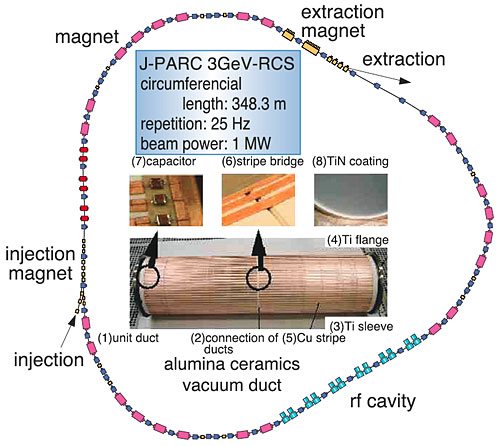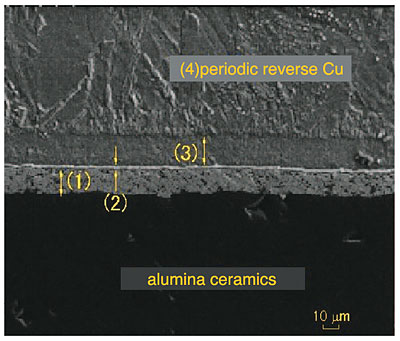A 3 GeV rapid cycling synchrotron (3 GeV RCS) in the Japan Proton Accelerator Research Complex (J-PARC) has a circumferencial length of ca. 350 m and is designed to generate a high power proton beam of 1 MW having a 25 Hz repetition rate of acceleration (Fig. 4-4). In the rapidly cycling magnetic field of the 3 GeV RCS, the eddy current effect in a metal duct would produce an unacceptable perturbation of the magnetic field and unnecessarily large ohmic losses.
Thus, almina ceramic duct was developed for use in the 3 GeV RCS. The ducts have copper (Cu) stripes on the outer surfaces of the ducts to reduce the duct impedance. The radio-frequency (rf) shield is designed as a high frequency pass filter, where eddy currents cannot be generated. In this shield, one end of each stripe is connected to a titanium (Ti) flange with a capacitor to interrupt the eddy current loop. We adopted Cu stripes as the rf shield. We also adopted an electroforming method, in which stripes of a Mo-Mn metallization layer was first sintered on the exterior surface and then overlaid with a layer of Cu using the periodic reverse electroforming (Fig. 4-5). The electrical conductivity of the periodic reverse Cu is almost the same as that of oxygen-free Cu. With this, the impedance of the duct with the rf shield was reduced to less than 6 ohm/m, which is within an allowable design limit. A TiN coating is widely used to suppress secondary emissions due to its chemical stability. We coated inside of the ceramic duct by TiN. The secondary electron emission efficiency became less than 1; that is, a charge build-up on the surface would be suppressed and undesirable clouds would be avoided. Thus, a low impedance ceramic duct was successfully developed for use on the J-PARC accelerators.
|

